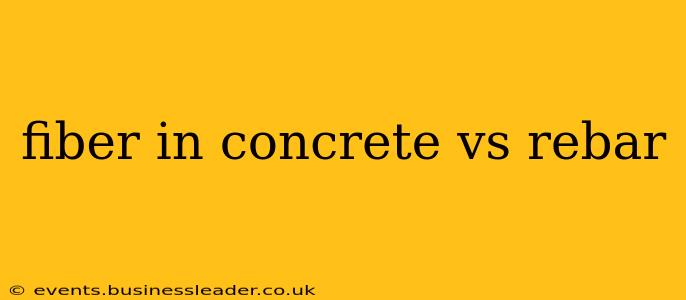Reinforcement in concrete is crucial for enhancing its structural integrity and durability. While steel rebar has long been the standard, fiber reinforcement offers a compelling alternative with unique advantages and disadvantages. This comparison explores the key differences between fiber-reinforced concrete (FRC) and traditional rebar-reinforced concrete to help you understand which option is best suited for your specific needs.
What is Fiber-Reinforced Concrete (FRC)?
Fiber-reinforced concrete incorporates short, discrete fibers within the concrete matrix. These fibers, typically made of steel, polypropylene, glass, or other materials, significantly enhance the concrete's tensile strength, impact resistance, and crack control. FRC is often used in applications where traditional rebar is impractical or uneconomical.
What is Rebar-Reinforced Concrete?
Rebar-reinforced concrete utilizes steel bars (rebar) embedded within the concrete. These continuous bars provide significant tensile strength, allowing the concrete to resist bending and cracking under load. Rebar is the industry standard for many structural applications due to its high strength and established design methodologies.
Fiber in Concrete vs. Rebar: Key Differences
Here's a head-to-head comparison of the two reinforcement methods:
Tensile Strength:
- Rebar: Offers superior tensile strength compared to most fiber types, especially for large structural elements.
- Fiber: Improves tensile strength and reduces cracking, but the overall tensile capacity may be lower than rebar in many applications. The type of fiber significantly impacts tensile strength. Steel fibers generally provide the highest strength.
Ductility:
- Rebar: Exhibits high ductility, meaning it can deform significantly before failure, providing warning signs of structural distress.
- Fiber: Generally offers less ductility than rebar. However, the brittle nature of concrete is mitigated by the numerous fibers which contribute to a more gradual failure.
Crack Control:
- Rebar: Controls cracking by providing tensile resistance, but cracks can still develop, potentially leading to corrosion of the rebar.
- Fiber: Provides excellent crack control by bridging cracks and preventing their propagation, reducing the risk of corrosion. This is particularly beneficial in applications exposed to harsh environmental conditions.
Impact Resistance:
- Rebar: Offers limited impact resistance; concrete with rebar can be susceptible to damage from impacts.
- Fiber: Significantly enhances impact resistance, making it ideal for applications requiring high impact resistance, such as pavements and industrial flooring.
Workability:
- Rebar: Requires skilled labor for placement and proper spacing, adding to construction time and cost.
- Fiber: Easy to mix and place, speeding up the construction process and reducing labor costs.
Cost:
- Rebar: The cost varies depending on the steel price and the project's rebar quantity; it's generally more expensive than fiber for smaller applications.
- Fiber: Generally less expensive than rebar, especially for smaller projects, but the cost depends on the fiber type and quantity used.
Corrosion Resistance:
- Rebar: Susceptible to corrosion when exposed to moisture and chlorides, leading to structural degradation.
- Fiber: Corrosion resistance varies depending on the fiber material; some fibers, like polypropylene, are inherently corrosion-resistant. Steel fibers can corrode unless properly protected.
Durability:
- Rebar: Durability can be compromised by corrosion.
- Fiber: Offers improved durability, particularly in applications with exposure to freeze-thaw cycles or aggressive chemicals, thanks to its superior crack control and corrosion resistance (depending on the fiber type).
Which is Right for Your Project?
The choice between fiber and rebar depends heavily on the specific application and project requirements:
- Large structural elements (buildings, bridges): Rebar is generally preferred due to its superior tensile strength and established design methodologies.
- Applications requiring high impact resistance (pavements, industrial floors): Fiber-reinforced concrete is highly advantageous.
- Applications requiring improved crack control and durability (exposed concrete, marine structures): FRC offers significant benefits.
- Smaller projects or applications where ease of placement is crucial: Fiber can reduce labor costs and accelerate construction.
This detailed comparison helps clarify the distinctions between fiber reinforcement and rebar in concrete. Careful consideration of project specifics, including the desired strength, durability, cost constraints, and environmental conditions, is paramount in selecting the appropriate reinforcement method.
